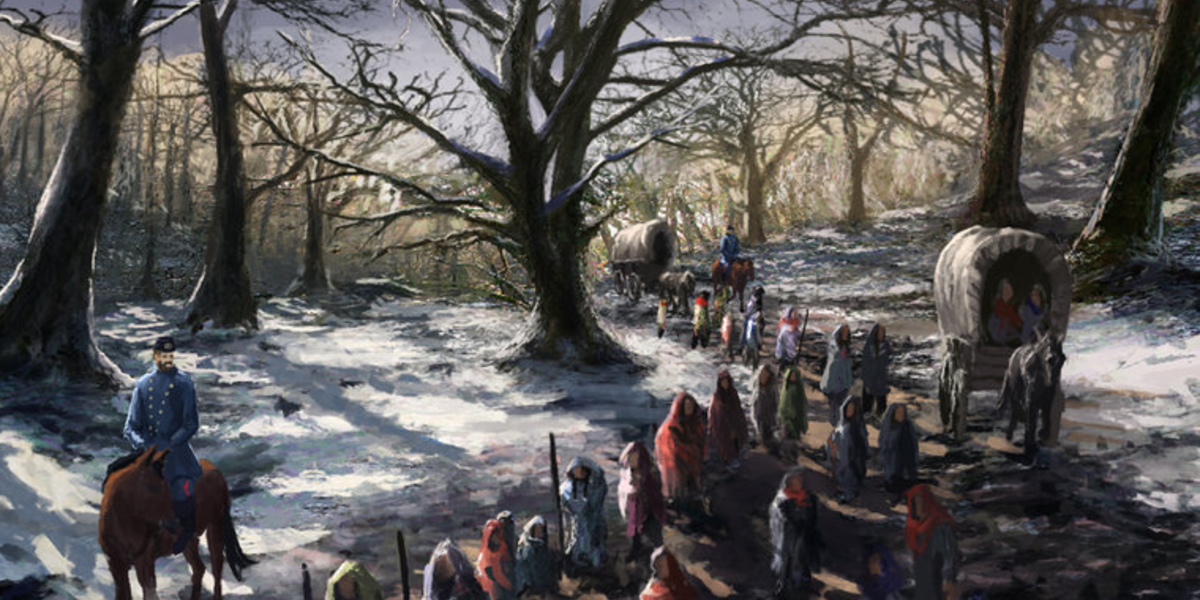
A representation of the forceful removal of Indigenous peoples from their homeland, courtesy of European settlers in the United States. Picture retrieved from “Trail of Tears Facts” by Piddlin.com.
Upon the first read of Susanna Moodie’s introduction to Roughing it in the Bush, one would think that the focus is on the European settler, emigrating from Britain to Canada. However, upon subsequent readings, the text can be read in such a way that it seems to be making mention beyond that which is at the surface level.
The opening paragraph begins with Moodie describing how “emigration is a matter of necessity, not of choice” (“Introduction” Paragraph 1) which I for one think is very interesting phrasing. (I would like to mention that I do recognize that many people emigrate because they are fleeing from worn-torn counties and do not have a choice; but I digress, back to the task at hand). It is interesting phrasing to me because it seems somehow ironic if Moodie is unaware of the plight of the vanishing Indian. If she is aware of this fact, then she seems to be point to the fact that the arrival of European settlers forcibly moved the Indigenous population out of “necessity” for their own means. She mentions in the next paragraph that one of the motivations for one emigrating from their homeland is to “escap[e] from the vulgar sarcasm too often hurled at the less-wealthy” (“Introduction” Paragraph 2) and I cannot help but think that these “less-wealthy” individuals is in reference to the Indigenous population. I would therefore argue, that while Moodie’s introduction begins with talk of her own family’s emigration, if one looks closer, she also seems to be talking about the Indigenous population.
Perhaps more miniscule, but I think its worth mentioning, is the allusion to the wilds of Canada being like that of Australia and Swan River. Moodie mentions how both the former mentioned were considered to be “El Dorados and lands of Goshen” (“Introduction” Paragraph 3) because of the bountiful riches that were expected to be found there. Canada is described as being like an oasis or a second Garden of Eden for those willing to risk going the distance. Yet while Moodie prefaces that this is how Canada was “sold” to those looking to better their position in life, the actual truth of the matter was that it was not so.
In the paragraphs following the description of Canada as being a bountiful land, ripe for the plundering, Moodie quickly dashes away those expectations. Here again, while she is describing mostly what was to be found for European settlers, her words invoke the idea that she is talking about those beyond the white population. Here is the first mention of how the “bountiful” land of Canada isn’t as plentiful as one is initially led to believe. In part, it seems, the land is harsher than what is described in the pamphlets Moodie mentions that were handed out to attract settlers.
Moodie moves on from talking about the housing conditions, said to be “raised in a single day” (“Introduction” Paragraph 4) and how they are nothing like the comforts of home, being mere “dens of dirt and misery” (“Introduction” Paragraph 4). In this article by Steve Lambert, he talks about how the sudden and forcible movement of Indigenous people from their territory in Manitoba in the 1950s lead to “housing [that] was inadequate” (Lambert 2017). Movements of a large population, such as the Sayisi Dene First Nations, makes me think of the log houses described by Moodie. Movements such as these were often unplanned and therefore the desperation for any kind of shelter would force the necessity of “single day” log houses in order to protect the migrants from the harsh elements of Canada.
Beyond the housing situation, Moodie describes how because of the remoteness of the settlements “the necessaries of life which would be deemed indispensable . . . could not be procured at all” (“Introduction” Paragraph 4). While Moodie clearly marks how it is Europeans she is talking about, I cannot help but think that the relocations of Indigenous peoples to settlements beyond that of their homeland made it harder for them to secure the necessities of life. Coupled with the fact that they were constantly having to be moved because the constant buying of land by Europeans “greatly enhanced the value and price of all other lands in the neighbourhood” (“Introduction” Paragraph 8), necessities of life would only become more and more scarce.
Susanna Moodie’s introduction to Roughing it in the Bush read as a warning to would be European settlers to think twice before making a go of the harsh environment of “unsettled” Canada. However, when one looks at how her words can apply to the Indigenous population, it almost feels as if she is talking about their troubles and issues, and not just about her own experience as a white settler. Therefore, I would make the claim that Moodie level of awareness is much higher than one might initially believe.
For more information about the forced movement of Indigenous peoples, I recommend reading about the US Trail of Tears which began around the 1830s; the same time that the gold rush swept through what is now British Columbia and California.
Work Cited
Lambert, Steve. “Manitoba offers land to Indigenous community forced to relocate in the 1950s.” CBC, Sept 20, 2017. https://www.cbc.ca/news/canada/manitoba/dene-land-offer-1.4299385. Accessed March 5th, 2021.
Moodie, Susanna. Roughing it in the Bush. Project Gutenburg EBook, 2003. https://www.gutenberg.org/files/4389/4389-h/4389-h.htm#link2H_INTR. Accessed March 3rd, 2021.
“Trail of Tears Facts.” Piddlin, Nov 3rd, 2020. https://piddlin.com/library/points-of-interest/trail-of-tears-facts. Accessed March 3rd, 2021.